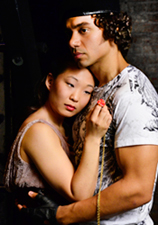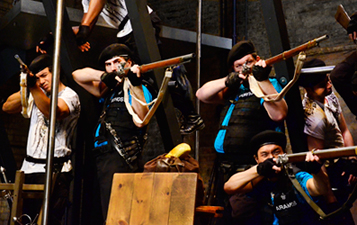From Windy City Times
June 19, 2013
By Mary Shen Barnidge
The average playgoer, asked about The Three Musketeers, will probably mumble something about sword-fights, big wigs and a scramble to recover a diamond necklace. You’ll find some of this in Robert Kauzlaric’s adaptation of the venerable Dumas sword-and-cloak classic, but the hallmark of this new page-to-stage translation is its adherence to the original source material, albeit illustrated in decidedly modern metaphors.
The first of these we notice is that our titular comrades are not the usual quartet of white guys, but an ethnically-diverse brotherhood rendering immediately recognizable the scorn heaped by cosmopolitan Parisians upon the southern-born D’Artagnan. The second is that the royal guards wear commando gear (T-shirts, berets, kevlar vests), in addition to the obligatory rapiers. More significantly, the boundaries of the warring factions — church and state, Catholic and Protestant, France, England and Spain — are laid out clearly, as are the conflicts they impose on individuals less steadfast in their loyalties as our “three inseparables,” and the senseless deaths engendered by the vanity of powerful men and calculating women.
This is not some stodgy PBS costume-drama, however, all elongated vowels and eyebrow-acting. Scenic designer Alan Donahue has stripped Lifeline’s stage to its bare walls and constructed thereupon a giant jungle-jim, replete with ladders, poles and cross-bars for climbing up, sliding down, spinning around, swinging on and dropping from.
Not only does this facilitate the kind of spectacle that sparked cheers and applause from the press-preview audience, but it allows the action to proceed at cartoon-swift pace without assuming likewise cartoon proportions. If the hitherto-definitive Richard Lester romp resembled a comic book, this is the graphic novel version, where innocent people die, villains go unpunished, and solitary heroes roam the mean streets, secure only in their own code of honor.
Portraying larger-than-life characters in an intimate space without slipping into hyperbolic camp is no easy task, but under Amanda Delheimer Dimond’s deft direction, Glenn Stanton carries off the coming-of-age subtext inherent in D’Artagnan’s progress, flanked by Chris Hainsworth, Dwight Sora, Christopher M. Walsh as his respective mentors. The ten actors filling the remaining 36 roles also retain their individual darkness — indeed, Katie McLean Hainsworth’s Milady de Winter emerges so irredeemably evil that her grisly execution by lynching is well-justified. The show’s run is rumored to be nearly sold out already, so don’t you wait to join in the fun and adventure.
From Chicago Stage Standard
June 9, 2013
By Angela Allyn
4 STARS (out of 4)
If you believe that great theater requires expensive, elaborate sets and costumes, and a state of the art theater with lots of bells and whistles, then you might miss one of the most exciting productions running this summer. The Lifeline Theatre adaptation of Alexandre Dumas’ classic adventure novel swashes and buckles, defends honor, goes for glory and keeps you on the edge of your seat for two and a half hours, even if, like me, you know the story well.
I have loved this story since I was a teen and discovered a dog eared translation lying in my house. The poor Gascon youth, Dartagnan, played with perfect naiveté and bravado, not to mention buff physicality, by Glenn Stanton, finds camaraderie and adventure with the likes of Athos, Porthos and Aramis in the twisted and dysfunctional court of Louis XIII. Lifeline ensemble members Chris Hainsworth and Christopher M. Walsh bring the tragic Athos and the affable Porthos to life. Guest artist Dwight Sora depicts a suitably ascetic (well mostly) Aramis. These men really personify the “All for One and One For All” credo that was so appealing to me as a teen. Watching the other 10 cast members nimbly portray another 3 dozen or so characters while navigating a simple set of platforms and grids that resembles a well designed playground while evoking everything from a castle to a dungeon to a rickety ship crossing the English Channel is a tribute to the strength of Lifeline’s ensemble of designers and the storytelling prowess of director Amanda Delheimer Dimond. The adaptation script, by Robert Kauzlaric, hits every major plotline in this complicated novel, yet moves us along at breathtaking pace.
And of course we have the swords. You cannot do the Three Musketeers without them and this production has LOTS and whips them out every scene or so. Oh, and the sword play has to be good: fast, believable and we don’t really want to see people get hurt; we just want to believe it is imminent. Fight choreographer Matt Hawkins had quite a job to do with the jungle gym set. But he succeeds: between the slashing and exploding, this becomes up close, in your face action, and it is thrilling.
The story is ultimately about the power of friendship in a world where power corrupts and allegiances are complicated. Speaking of shifting alliances: Katie McLean Hainsworth out “evils” the Cardinal as the resident baddie in this version, playing Milady with such devious duplicity that she nearly got boos at the bows.
The show and this version of the tale ends with a disheartening comment on the double edged nature of leadership, a message so timely in an era when our governmental bodies seem incapable of actually governing. It’s too bad this production isn’t taking place during the school year: I could see busloads of high schoolers transformed and discussing the power of this narrative and how the lessons learned by our hero apply today. But it IS summer reading season, so head to Rogers Park and avail yourself of the best storefront adventure on the docket, then pick up a copy of the novel in the lobby and walk over to the beach to relive the glow and savor the story again.
From the Chicago Reader
June 10, 2013
By Zac Thompson
Recommended
Alexandre Dumas’s 1844 adventure novel, adapted for the stage by Robert Kauzlaric, pits newbie musketeer d’Artagnan and the inseparable trio of Athos, Porthos, and Aramis against a scheming cardinal, a one-eyed count, and a viperous female assassin. In keeping with the conventions of 19th-century melodrama, good battles evil in a plot propelled by coincidence, eavesdropping, misdelivered letters, and mislaid jewelry. Amanda Delheimer Dimond’s thrill-a-minute production unfolds on a set (designed by Alan Donahue) filled with ladders to climb and fireman’s poles to slide down, ensuring that no swash goes unbuckled. The breakneck pacing makes the story difficult to follow at times, but thanks to thrilling swordplay choreographed by Matt Hawkins and the cast’s energetic performances, it hardly matters.
From the Chicago Tribune
June 11, 2013
By Chris Jones
“With a wild set from Alan Donahue that resembles a high-tech adventure playground more than 17th-century France — think horizontal bars, ladders and fireman’s poles — the production is a terrific showcase for the ebullient fight choreography of Matt Hawkins, who seizes this particular opportunity like a modern-day D’Artagnan. Touche, indeed. Luckily for Hawkins and his audience, Athos, Porthos and Aramis like to do their sword work en masse, a communal spirit that Hawkins adroitly exploits. If you’re of the “seen-one-fight-seen-’em-all” school, you’ll be struck by the genuine freshness of Hawkins’ work, partly because Donahue’s set features so many diagonal structures that the blade scenes are constantly pushed into new and interesting visual directions.”
From the Huffington Post
June 14, 2013
By Kelly Kleiman
“Robert Kauzlaric’s adaptation is vintage Lifeline, wringing stage clarity out of textual complexity. Few contemporary Americans (or contemporary Frenchmen, for that matter) could explain the significance of Cardinal Richelieu’s sway over the French king or the rivalry between the Cardinal’s militia and the Queen’s guard or the relationship of either to Musketeers fighting in England. But Kauzlaric renders it all clear with just a well-chosen word here or there. And Matt Hawkins’s fight choreography is absolutely phenomenal, almost terrifyingly so, as the actors simultaneously sword fight, kick-box, slide and leap across Alan Donahue’s spare yet flexible set.”
From Stage and Cinema
OPULENT PLOT, THRILLING FIGHTING, AND A STUDLY D’ARTAGNAN
June 10, 2013
By Samantha Nelson
While it’s brought to film more than a dozen times, Alexandre Dumas’ The Three Musketeersis a tough work to adapt. It’s long, has a huge character list, and has as much courtly intrigue as sword fighting. But Robert Kauzlaric, who previously wrote scripts from other oft-adapted novels The Island of Dr. Moreau and The Picture of Dorian Gray for Lifeline Theatre, strikes the perfect balance in his adaptation, offering the potent mix of buddy comedy, war story, romance, and morality tale that has made the work a classic.
That script is brought to life by the creative choices of director Amanda Delheimer Dimond, who keeps things going even at the tale’s slower points by never having a lull in the action on stage. Characters are constantly skulking about spying on each other or setting up ambushes so that a quiet conversation can suddenly erupt into a fight or a dramatic confrontation, and no time is lost waiting for the scene to change. It’s important to keep things moving since the number of subplots otherwise threaten to bog the story down.
Scenic designer Alan Donahue has created an adult-sized jungle gym on Lifeline’s small stage, offering poles, ladders, ramps and two levels that the actors utilize in outrageous feats of acrobatics and stage fighting (the exhilarating swashbuckling is beautifully constructed by fight choreographer Matt Hawkins). Yet the strange equipment is subtle enough that it doesn’t get in the way of the set becoming a tavern, a palace bedroom, or an isolated convent.
That spectacle is a lot of fun, but the play is anchored by Glenn Stanton’s D’Artagnan. The country boy who comes to Paris dreaming of joining the renowned Musketeers is endearing throughout his transformation from a temperamental kid willing to provoke duels over the smallest slight to a love struck soldier and eventually a wily hero. His striking good looks add to his appeal (he was the talk of the ladies’ bathroom during intermission) and Dimond is all too happy to use that to her advantage, constructing multiple excuses for Stanton to take off his shirt.
Chris Hainsworth, Dwight Sora, and Christopher M. Walsh are all excellent as the titular musketeers, especially Hainsworth’s tortured portrayal of Athos. But the best acting is done by Katie McLean as Milady de Winter. She’s such a perfect villainess, beautifully manipulating even the most loyal and noble characters around her and the audience in turn. It’s hard not to feel bad for her when she’s punished, even though she really, really deserves it.
While the supporting cast is mostly strong, Miguel Nunez is a weak link. His distinctive voice is perfect for the pompous King Louis XIII but he can’t alter it enough to slip into the character of Lord Buckingham, which makes it hard to view the romantic rivals as separate characters. Another flaw in the show comes from Aly Renee Amidei’s costumes. The French nobility and clergy dress in period garb while the British wear simple suits. The anachronism works for the soldiers, who dress in bright-colored T-shirts, berets and — in the case of the musketeers — jackets with convenient nametags; it manifests the idea of a uniform and helps distinguish between sides. But for the British nobles, it just makes them seem unimportant.
Fortunately those are just minor distractions and it’s easy to ignore them when your attention is called back to the rich plot and spectacular fights.
From Spotlight on Lake
Swordfights and Muskets featured in “The Three Musketeers”
June 14, 2013
By Carol Moore
FOUR SPOTLIGHTS
A young man, D’Artagnon (the very buff Glenn Stanton), who dreams of becoming a Musketeer like his late father, kisses his mother (Mildred Marie Langford) goodbye, as he’s leaving for Paris. Of course the Parisians recognize a provincial and make fun of him. Unfortunately, full of youthful swagger, D’Artagnon challenges one of his tormentors, who turns out to be the Comte De Rochefort (Mike Ooi), to a duel, which he loses.
When he meets the Three Inseparables, one at a time, he aggravates each of them into a duel. When he goes to meet Porthos (Christopher M. Walsh), he’s surprised to learn that Athos (Chris Hainsworth) and Aramis (Dwight Sora) are his seconds. When they find out about his father, they take D’Artagnon under their collective wing.
D’Artagnon’s bravery catches the eye of the very swishy King Louis XIII (Miguel Nunez), earning him an appointment to the King’s guard. One day, his landlord, Monsieur Bonacieux (Carlos Rogelio Diaz), tells D’Artagnon that his wife, Constance (Deanna Myers), the Queen’s seamstress, has been arrested and asks him to go to the Queen for help. The Queen gets Constance — who turns out to be the love of D’Artagnon’s life, even though she’s already married — out of jail, bringing him and cowardly Monsieur Bonacieux to the attention of the evil Cardinal Richelieu (Sean Sinitski) who has sent his beautiful minion, the depraved Milady de Winter (Katie McLean Hainsworth) to England to kill the Duke of Buckingham (Nunez). When the Queen learns about Milady’s task, she sends D’Artagnon to London with a letter warning Buckingham, the man she loves.
“The Three Musketeers” has 14 actors playing more than 50 roles. In designating certain roles, I’ve thrown in some convenient abbreviations such as – Musketeers and King’s Guards (M&KG), the Cardinal’s Guards (CG), British Barons and Soldiers (BBS) and Drunkards, Innkeepers & Inn Patrons (DIIP).
The actors playing D’Artagnon, Athos, Porto’s, Aramids, and Milady have one role, everyone else has at least two. Mildred Marie Langford plays D’Artagnon’s Mother, Queen Anne, Madame Coquenard, an attorney’s wife and Porthos’ mistress, and Kitty, Milady’s maidservant. Miguel Nunez plays the King, Buckingham and DIIP. Adrian Byrd is both Monsieur de Treville, Captain of the Musketeers and CG. Deanna Myers is Constance and DIIP. Sean Sinitski is Cardinal Richelieu and one of his Guards (CG). Mike Ooi plays the Comte de Rochefort and Milady’s despised English husband, Lord de Winter. Kyle Vincent Terry is M&KG, a Murderer, BBS, a Priest and DIIP. Dan Lin is Felton, M&KG, CG, BBS and DIIP. Finally, Carlos Rogelio Diaz, laying claim to the most roles, is Monsieur Bonacieux, Pierre de LaPorte, the queen’s cloak bearer, a Mendicant, M&KG, CG, BBI and DIIP.
Lifeline Scenic & Properties Designer Alan Donahue’s motto must be less is best. Using a bare stage, he added horizontal and vertical poles and ladders connecting with each other and two small platforms on opposite sides. In different combinations, they became the varied locations in “The Three Musketeers” — a forest, a fort, a battlefield, rooms in the palace, an inn, the Cardinal’s residence, even a ship’s mast.
Fight Choreographer Matt Hawkins is to be congratulated for the spectacular sword fight involving nine actors (D’Artagnon, the Three Inseparables and the five Cardinal’s Guards). In addition to dueling, he’s incorporated some gymnastics which adds a whole new level of difficulty. At the end of the fight — which lasted several minutes — the audience cheered.
The M&KG, CG and BBS all wear uniforms consisting of T-shirts with black cargo pants and boots. The Musketeers have bright blue T-shirts and black vests with their names above the pocket flap. The King’s Guards wear white T-Shirts, the Cardinal’s Guards wear red.
I really enjoyed the swashbuckling performances in Robert Kauzlaric’s adaptation of “The Three Musketeers.”
From chicagocritic.com
June 15, 2013
By Anthony J. Mangini
Recommended
“Without a doubt, Lifeline Theatre’s recent stage adaptation of French novelist Alexandre Dumas’s The Three Musketeers contains all the adrenaline-pumping athleticism and quick-turning escapades one may dutifully expect from this timeless adventure story.And director Amanda Delheimer Dimond’s frequently ingenuous staging — featuring fourteen performers as fifty different characters, set across two countries and over a span of three years — successfully marshals the disparate elements of Dumas’s gargantuan story into something as teasingly thrilling as any Six Flags roller coaster ride. Matt Hawkins fight choreography is especially cinematic in its no holds barred intensity, and sprawls with a kind of epic free-for-all over Alan Donahue’s jungle gym-set of firepoles, balancing beams, and ladders.”































